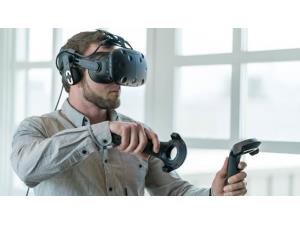



Date:22/04/19
 While some visually impaired users find they can see more clearly in VR than in the real world, vision problems exist across a wide spectrum where one solution won’t work for everybody.
While some visually impaired users find they can see more clearly in VR than in the real world, vision problems exist across a wide spectrum where one solution won’t work for everybody.
That’s why a research team at Microsoft has been working on SeeingVR: a set of 14 tools designed to make virtual reality accessible to visually-impaired users.
“While desktop software offers some accommodation features for people with low vision (for example, screen magnifiers), VR systems have not yet grappled with the issue of accessibility for this audience,” wrote Microsoft’s Meredith Ringel Morris in a blog post summarising the research. “Indeed, when interviewing VR developers, the team found that none had received training or guidance on how to develop accessible VR experiences.”
Microsoft’s tools range from simple text to voice readers all the way up to a magnifier that can be pointed at objects and text to help players see everything more clearly.
Other options boost the contrast or brightness, while another highlights objects and scenery with a brightly-coloured border helping them to stand out. You can get a better idea of the full arsenal of improvements in the video below.
The tools are all designed in Unity, which was chosen on account of it being one of the most widely-used VR development platforms available. Microsoft says that the “majority of these tools” can be added to existing Unity applications in a post-hoc manner, which will hopefully help adoption.
Microsoft tested SeeingVR on 11 participants with various vision problems and found that every one of them completed tasks more quickly in game than with the unmodified originals. Obviously that’s quite a small sample size, but it’s a very encouraging start – especially as Morris reports that the participants opted to pick their own combination of settings: a one-size-fits-all approach would likely not have had the same level of success.
Microsoft has published its full findings in a research paper, and the company will be presenting SeeingVR at the CHI Conference on Human Factors in Computer Systems next month.
Microsoft’s SeeingVR toolkit helps visually-impaired players enjoy virtual reality
 While some visually impaired users find they can see more clearly in VR than in the real world, vision problems exist across a wide spectrum where one solution won’t work for everybody.
While some visually impaired users find they can see more clearly in VR than in the real world, vision problems exist across a wide spectrum where one solution won’t work for everybody.That’s why a research team at Microsoft has been working on SeeingVR: a set of 14 tools designed to make virtual reality accessible to visually-impaired users.
“While desktop software offers some accommodation features for people with low vision (for example, screen magnifiers), VR systems have not yet grappled with the issue of accessibility for this audience,” wrote Microsoft’s Meredith Ringel Morris in a blog post summarising the research. “Indeed, when interviewing VR developers, the team found that none had received training or guidance on how to develop accessible VR experiences.”
Microsoft’s tools range from simple text to voice readers all the way up to a magnifier that can be pointed at objects and text to help players see everything more clearly.
Other options boost the contrast or brightness, while another highlights objects and scenery with a brightly-coloured border helping them to stand out. You can get a better idea of the full arsenal of improvements in the video below.
The tools are all designed in Unity, which was chosen on account of it being one of the most widely-used VR development platforms available. Microsoft says that the “majority of these tools” can be added to existing Unity applications in a post-hoc manner, which will hopefully help adoption.
Microsoft tested SeeingVR on 11 participants with various vision problems and found that every one of them completed tasks more quickly in game than with the unmodified originals. Obviously that’s quite a small sample size, but it’s a very encouraging start – especially as Morris reports that the participants opted to pick their own combination of settings: a one-size-fits-all approach would likely not have had the same level of success.
Microsoft has published its full findings in a research paper, and the company will be presenting SeeingVR at the CHI Conference on Human Factors in Computer Systems next month.
Views: 443
©ictnews.az. All rights reserved.Similar news
- Azerbaijani project to monitor disease via mobile phones
- Innovative educational system to be improved under presidential decree
- NTRC prolongs license of two TV and radio organizations for 6 years
- Azerbaijan establishes e-registry for medicines
- Azerbaijani museum introduces e-guide
- Nar Mobile opens “Nar Dunyasi” sales and service center in Siyazan city
- International conference on custom electronic services held in Baku
- OIC secretary general to attend COMSTECH meeting in Baku
- Azerbaijan develops earthquake warning system
- New law to regulate transition to digital broadcasting in Azerbaijan
- Azerbaijani State Social Protection Fund introduces electronic digital signature
- Intellectual traffic management system in Baku to be commissioned in December
- Tax Ministry of Azerbaijan started receiving video-addresses
- World Bank recommends Azerbaijan to speed up e-service introduction in real estate
- Azerbaijan to shift to electronic registration of real estate





















